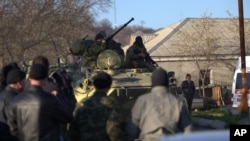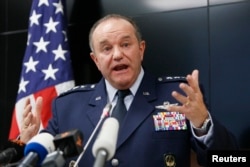The top U.S. general in Europe said he is alarmed at the Russian militarization of the Black Sea peninsula of Crimea and by provocative Russian military flights in NATO airspace.
After meeting with Ukrainian leaders in Kyiv, General Philip Breedlove, head of the U.S. European Command and NATO Supreme Allied Commander Europe, said the military buildup by Moscow includes cruise and surface-to-air missiles able to exert, as he put it, "military influence" on the region.
“We are very concerned with the militarization of Crimea. We are concerned that the capabilities in Crimea that are being installed will bring an effect on almost the entire Black Sea,” Breedlove said.
Breedlove also voiced concern about the nature of provocative Russian military flights being flown over NATO countries, although he stressed the flights are in international airspace.
“The number and pattern has changed, maybe as much as three times as much as we have seen before,” he said. “Also, we see that some of these flights have increased in size, normally before seeing only one or two airplanes and now seeing groups of airplanes.”
Increase in Russian fly-overs
Last month, NATO reported an "unusual" spike in Russian military flights over the Black, Baltic and North seas and the Atlantic Ocean.
Several European governments, including Britain’s, say they have scrambled jets in response to what NATO spokesmen describe as large-scale maneuvers. And they claim the Russian warplanes frequently fly with their transponders switched off, creating a potential hazard for commercial aircraft.
According to NATO officials, alliance pilots have conducted over 100 intercepts of Russian aircraft this year – about three times more than in 2013 and an interception rate reminiscent of the Cold War.
Tensions have been running high between NATO and Russia since Moscow began backing an insurgency by pro-Kremlin militants in eastern Ukraine.
Breedlove four times shied away from revealing whether he thinks the Obama administration should supply Ukraine with arms and other lethal weaponry, as requested by Ukraine's President Petro Poroshenko.
"We continue to look at the requirements here in Ukraine. We continue to advise and offer our thoughts on these, and nothing at this time is off the table," he said.
This week, President Barack Obama’s nominee for the No. 2 slot in the U.S. State Department told American lawmakers during nomination hearings that he thinks the White House should consider arming Ukraine as a way of forcing Russia to rethink its policy toward its neighbor.
Military aid package
So far, the U.S. has restricted a $118 million military aid package to non-lethal items such as body armor and night vision devices, although it is also delivering three portable anti-mortar radar systems.
The Kremlin, which denies it is fomenting the insurgency in the east or that Russian soldiers and armor have crossed the border, has warned that any arming of Ukraine by the U.S. would be seen as a provocation.
Breedlove’s caution on whether the U.S. should now consider providing lethal aid will come as a disappointment to Ukrainian military commanders and leaders of volunteer battalions.
Yuriy Bereza, commander of the Ukrainian Dnipro battalion, recently was in Washington seeking to persuade the administration to supply military equipment.
He said he needs surveillance drones from America and Javelins – portable anti-tank missiles.








